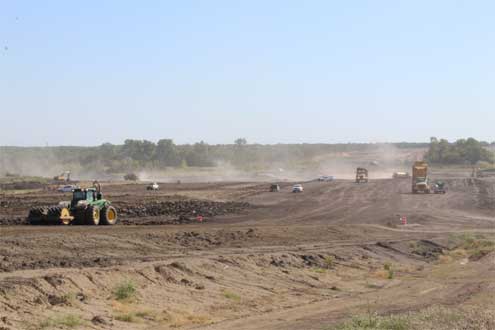Fannin County, Texas -- A recent Fannin County fossil find of a Tylosaurus in July, on a section of the North Sulphur River owned by Upper Trinity Regional Water District (UTRWD), continues to tell paleontologists a story written approximately 100 million years ago, when much of Texas was covered by a huge inland sea.
According to Ronald S. Tykoski, Ph.D., Vice President of Science & Curator of Vertebrate Paleontology at the Perot Museum of Nature and Science, paleontologists are planning to work with UTRWD later this year into early 2023 to recover the rest of the specimen.
Tylosaurus are part of the Mosasaurus family, giant predatory marine reptiles which grew to more than 40 feet in length (the length of a semi-truck trailer) and weighed up to 15 tons (about two elephants), making them one of the largest and most ferocious sea predators ever. Its jaws were lined on each side with two rows of pointy, cone-shaped teeth. Tylosaurus used its snout to locate prey, which, once inside the sea monster’s menacing jaws, was swallowed whole.

Staff and volunteers at the Perot Museum have been working on one of the large blocks of Tylosaurus bones collected in July. Museum visitors can watch this work in real-time, through a plexiglass viewing window at the fossil prep lab in the paleontology hall.
The block has produced the entire right lower jaw, some bones from the left lower jaw, part of the tip of the snout, and the right upper jawbone. Two other large blocks containing more of the skull, as well as a medium block still need to be investigated meaning work on the Cretaceous creature can be viewed by public for several months to come.
“Large vertebrate fossil specimens as complete as this one are hard to come by,” said Dr. Tykoski. “This is a big Tylosaurus and beautifully preserved, with great detail present in the bones which gives researchers the chance to look at subtle details and anatomical nuances - telling us a lot more about these extinct animals.”
Once all the bones are fully cleaned up, they will be taken to the museum’s collection facility for safe storage, care and further study.
Lake progress - in a snapshot

- Workers are getting ready to pour concrete for the spillway and continue to move dirt to build the dam’s embankment. They have finished removing brush and trees from the dam location.
-
The SH 34 bridge is getting its final coat of concrete and nearing completion. Merrill Creek Bridge and other Farm-to-Market and county road work is still in process.
-
The pipeline and pump station designs are moving forward with both projects on schedule to break ground next spring/summer.
-
Mitigation plans are moving forward, as are plans for shoreline management.